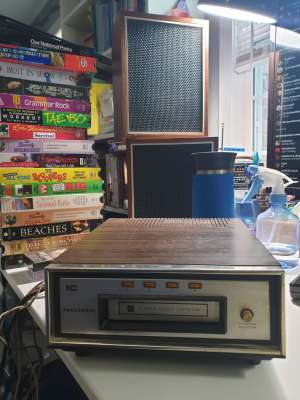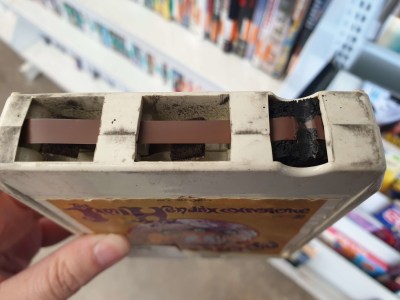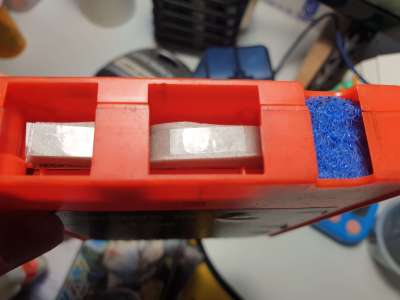What was the worst thing about the 70s? Some might say the oil crisis, inflation, or even disco. Others might tell you it was 8-track tapes, no matter what was on them. I’ve heard that the side of the road was littered with dead 8-tracks. But for a while, they were the only practical way to have music in the car that didn’t come from the AM/FM radio.
If you know me at all, you know that I can’t live without music. I’m always trying to expand my collection by any means necessary, and that includes any format I can play at home. Until recently, that list included vinyl, cassettes, mini-discs, and CDs. I had an 8-track player about 20 years ago — a portable Toyo that stopped working or something. Since then, I’ve wanted another one so I can collect tapes again. Only this time around, I’m trying to do it right by cleaning and restoring them instead of just shoving them in the player willy-nilly.
Update: I Found a Player

A couple of weeks ago, I was at an estate sale and I found a little stereo component player and speakers. There was no receiver in sight. I tested the player with the speakers and bought them for $15 total because it was 75% off day and they were overpriced originally. While I was still at the sale, I hooked it up to the little speakers and made sure it played and changed programs.
Well, I got it home and it no longer made sound or changed programs. I thought about the play head inside and how dirty it must be, based on the smoker residue on the front plate of the player. Sure enough, I blackened a few Q-tips and it started playing sweet tunes again. This is when I figured out it wouldn’t change programs anymore.
I found I couldn’t get very far into the player, but I was able to squirt some contact cleaner into the program selector switch. After many more desperate button presses, it finally started changing programs again. Hooray!
I feel I got lucky. If you want to read about an 8-track player teardown, check out Jenny List’s awesome article.
These Things Are Not Without Their Limitations

So now, the problem is the tapes themselves. I think there are two main reasons why people think that 8-tracks suck. The first one is the inherent limitations of the tape. Although there were 90- and 120-minute tapes, most of them were more like 40-60 minutes, divided up into four programs. One track for the left channel, one for the right, and you have your eight tracks and stereo sound.
The tape is in a continuous loop around a single hub. Open one up and you’ll see that the tape comes off the center toward the left and loops back onto the outside from the right. 8-tracks can’t be rewound, only fast-forwarded, and it doesn’t seem like too many players even had this option. If you want to listen to the first song on program one, for instance, you’d better at least tolerate the end of program four.
The tape is divided into four programs, which are separated by a foil splice. A sensor in the machine raises or lowers the playback head depending on the program to access the appropriate tracks (1 and 5, 2 and 6, and so on.)
Because of the 10-12 minute limitation of each program, albums were often rearranged to fit better within the loud solenoidal ka-chunk of each program change.
For a lot of people, this was outright heresy. Then you have to consider that not every album could fit neatly within four programs, so some tracks faded out for the program change, and then faded back in, usually in the middle of the guitar solo.
Other albums fit into the scheme with some rearrangement, but they did so at the expense of silence on one or more of the programs. Check out the gallery below to see all of these conditions, plus one that divided up perfectly without any continuations or silence.

This one has a repeated track, presumably to fill out the thing so there’s no silence.

This one has 1:00 of silence at the end of program four.

This one has no silences or continuations between programs, but the track order has been rearranged. And of course, no gatefold cover.

This one has two continuations, but at least they didn’t do it to “Spinning Wheel” or “You’ve Made Me So Very Happy”. Splitting hits totally did happen, though.

This one has THREE continuations! They really did Dolly dirty.
The second reason people dislike 8-tracks is that they just don’t sound that good, especially since cassette tapes were already on the market. They didn’t sound super great when they were new, and years of sitting around in cars and dusty basements and such didn’t help. In my experience, at this point, some sound better than others. I suppose after the tape dropout, it’s all subjective.
What I Look For When Buying Tapes
The three most important things to consider are the pressure pads, the foil splices, and the pinch roller. All of these can be replaced, although some jobs are easier than others.
Start by looking at the pressure pads. These are either made of foam that’s covered with a slick surface so the tape can slide along easily, or they are felt pads on a sproingy metal thing like a cassette tape. You want to see felt pads when you’re out shopping, but you’ll usually see foam. That’s okay. You can get replacement foam on ebay or via 8-track avenue directly, or you can do what I do.

Replacement pads!

This foam is trashed and needs replacing.

Dolly is missing both felt pads!

This original foam looks good, but I don’t trust it.

Bad vs. good pinch rollers.
After removing the old foam and scraping the plastic backing with my tweezers, I cut a piece of packing tape about 3/8″ wide — just enough to cover the width of some adhesive foam window seal. The weatherstripping’s response is about the same as the original foam, and the packing tape provides a nice, slick surface. I put a tiny strip of super glue on the adhesive side and stick one end down into the tape, curling it a little to rock it into position, then I press it down and re-tension the tape. The cool part is that you can do all this without opening up the tape by just pulling some out. Even if the original foam seems good, you should go ahead and replace it. Once you’ve seen the sticky, black powder it can turn to with time, you’ll understand why.

Another thing you can address without necessarily opening up the tape are the foil splices that separate the programs. As long as the pressure pads are good, shove that thing in the player and let it go until the ka-chunk, and then pull it out quickly to catch the splice. Once you’ve got the old foil off of it, use the sticky part of a Post-It note to realign the tape ends and keep them in place while you apply new foil.
Again, you can get sensing foil on ebay, either in a roll, or in pre-cut strips that have that nice 60° angle to them. Don’t try to use copper tape like I did. I’ll never know if it worked or not, because I accidentally let too much tape un-spool from the hub while I was splicing it, but it seemed a little too heavy. Real-deal aluminium foil sensing tape is even lighter-weight than copper tape.
One thing you can’t do without at least opening the tape part way is to replace the pinch roller. Fortunately, these are usually in pretty good shape, but you can usually tell right away if they are gooey without having to press your fingernail into it. Even so, I have salvaged the pinch rollers out of tapes I have tried to save and couldn’t, just to have some extras around.
If you’re going to open the tape up, you might as well take some isopropyl alcohol and clean the graphite off of the pinch roller. This will take a while, but is worth it.
Other Problems That Come Up
Sometimes, you shove one of these bad boys in the player and nothing happens. This usually means that the tape is seized up and isn’t moving. Much like blowing into an N64 cartridge, I have heard that whacking the tape on your thigh a few times will fix a seized tape, but so far, that has not worked for me. I have so far been unable to fix a seized tape, but there are guides out there. Basically, you cut the tape somewhere, preferably at a foil splice, fix the tension, and splice it back together.
Another thing that can happen is called a wedding cake. Basically, you open up the cartridge and find that the inner loops of tape have raised up around the hub, creating a two-layer effect that resembles a wedding cake. I have not so far successfully fixed such a situation, but I’ve only run across one so far. Basically, you pull the loops off of the center, re-tension the tape from the other side, and spin those loops back into the center. This person makes it look insanely easy.
Preventive Maintenance On the Player
As with cassette players, the general sentiment is that one should never actually use a head-cleaning tape as they are rough. As I said earlier, I cleaned the playback head thoroughly with 91% isopropyl alcohol and Q-tips that I wished were longer.

Another thing I did to jazz up my discount estate sale player was to make a capstan-cleaning tape per these instructions on 8-Track Avenue. Basically, I took my poor Dionne Warwick tape that I couldn’t fix, threw away the tape, kept the pinch roller for a rainy day, and left the pressure pads intact.
To clean the capstan, I took a strip of reusable dishrag material and stuffed it in the place where the pinch roller goes. Then I put a few drops of alcohol on the dishrag material and inserted the tape for a few seconds. I repeated this with new material until it came back clean.
In order to better grab the tape and tension it against the pinch roller, the capstan should be roughed up a bit. I ripped the scrubby side off of an old sponge and cut a strip of that, then tucked it into the pinch roller pocket and let the player run for about ten seconds. If you listen to a lot of tapes, you should do this often.
Final Thoughts
I still have a lot to learn about fixing problematic 8-tracks, but I think I have the basics of refurbishment down. There are people out there who have no qualms about ironing tapes that have gotten accordioned, or re-spooling entire tapes using a drill and a homemade hub-grabbing attachment. If this isn’t the hacker’s medium, I don’t know what is. Long live 8-tracks!
